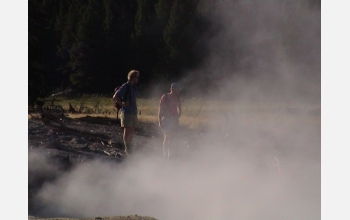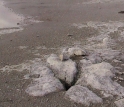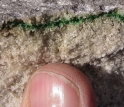|

Press Release 05-060
Yellowstone Discovery Bodes Well for Finding Evidence of Life on Mars

Fossilized microbes can remain in the geologic record
April 20, 2005
Researchers say a bizarre group of microbes found living inside rocks in an inhospitable geothermal environment at Wyoming's Yellowstone National Park could provide tantalizing new clues about ancient life on Earth and help steer the hunt for evidence of life on Mars.
University of Colorado at Boulder (CU-Boulder) scientists Jeffrey Walker, John Spear and Norman Pace report the finding in the April 21 issue of the journal Nature.
The research was funded by the National Science Foundation's Division of Environmental Biology and NASA.
The CU-Boulder research team reported that the microbes were discovered in the pores of rocks in a highly acidic environment with high concentrations of metals and silicates at roughly 95 degrees Fahrenheit in Yellowstone's Norris Geyser Basin. The new study shows that the microbe communities are subject to fossilization and have the potential to become preserved in the geologic record.
Scientists believe similar kinds of geothermal environments may once have existed on Mars, where astrobiologists have intensified the search for past and present life forms in recent years.
"This is the first description of these microbial communities, which may be a good diagnostic indicator of past life on Mars because of their potential for fossil preservation," said Walker. "The prevalence of this type of microbial life in Yellowstone means that Martian rocks associated with former hydrothermal systems may be the best hope for finding evidence of past life there."
Located about 20 miles northwest of Yellowstone Lake, Norris Geyser Basin is considered to be the hottest and most-active geyser basin in Yellowstone and perhaps the world. It also is extremely acidic, according to the researchers.
"The pores in the rocks where these creatures live has a pH value of one, which dissolves nails," said Pace. "This is another example that life can be robust in an environment most humans view as inhospitable."
Walker discovered the new microbe community in 2003 after breaking apart a chunk of sandstone-like rock in the Norris Geyser Basin. An analysis determined that a green band within the rock was caused by a new species of photosynthetic microbes in the cyanidium group, a kind of alga that is among the most acid-tolerant photosynthetic organisms known, said Walker. Cyanidium organisms made up about 26 percent of the microbes identified in the Norris Geyser Basin study.
Surprisingly, the most abundant microbes identified by the team were a new species of mycobacterium, a group of microbes best known for causing human illnesses like tuberculosis and leprosy, Walker said. Extremely rare and never before identified in such extreme hydrothermal environments, mycobacterium made up 37 percent of the total number of microbes.
Pace described the new life form in the Norris Geyser Basin as "pretty weird. It may well be a new type of lichen-like symbiosis. It resembles a lichen, but instead of being a symbiosis between a fungus and an alga, it seems to be an association of the mycobacterium with an alga."
While photosynthesis appears to be a key energy source for most of the creatures, at least some of Yellowstone microbes are believed to get energy from the dissolved metals and hydrogen found in the pore water of the rock, Walker said.
The research effort in the Norris Geyser Basin shows that rock formation processes occurring in this hydrothermal environment make fossil imprints of the organisms embedded in the rock at various stages, showing how the distinctive fossils develop over time, according to the research team.
"Remnants of these communities could serve as 'biosignatures' and provide important clues about ancient life associated with geothermal environments on Earth or elsewhere in the Solar System," the authors wrote.
-NSF-

Media Contacts
Cheryl L. Dybas, NSF (703) 292-7734 cdybas@nsf.gov
Jim Scott, University of Colorado at Boulder (303) 492-3114 jim.scott@colorado.edu

The National Science Foundation (NSF) is an independent federal agency that supports fundamental research and education across all fields of science and engineering. In fiscal year (FY) 2009, its budget is $9.5 billion, which includes $3.0 billion provided through the American Recovery and Reinvestment Act. NSF funds reach all 50 states through grants to over 1,900 universities and institutions. Each year, NSF receives about 44,400 competitive requests for funding, and makes over 11,500 new funding awards. NSF also awards over $400 million in professional and service contracts yearly.
 Get News Updates by Email Get News Updates by Email
Useful NSF Web Sites:
NSF Home Page: http://www.nsf.gov
NSF News: http://www.nsf.gov/news/
For the News Media: http://www.nsf.gov/news/newsroom.jsp
Science and Engineering Statistics: http://www.nsf.gov/statistics/
Awards Searches: http://www.nsf.gov/awardsearch/
| 



